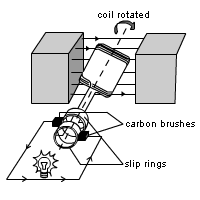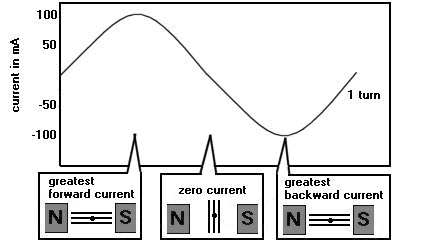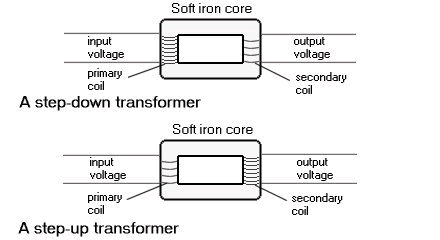Generators and Transformers
Induced Current
Magnetic fields can be used to produce electric currents. This idea is used in generators to produce electricity and in transformers to increase or decrease voltage.
If a magnet is moved into a coil of wire that is part of a circuit, a current is produced (induced) in the wire.
If the magnet is moved out of the coil, or the opposite pole of the magnet is moved into the coil, the direction of the induced current is reversed.
Alternatively, a current can be induced in the wire by moving the wire at right angles across a magnetic field.
A voltage is produced between the ends of the wire when the wire, or coil, cuts through the magnetic field lines.
The induced voltage causes a current to flow through the wire.
The size of the induced voltage increases when:
- The speed of movement increases
- The strength of the magnetic field increases
- The number of turns on the coil is increased
- The area of the coil is greater

Generators
A generator uses the idea of electromagnetic induction to produce electricity. A coil of wire is rotated in a magnetic field, or a magnet is rotated inside a coil of wire.
Slip rings are fixed to the coil, which turn with it.
Carbon brushes push against the slip rings to maintain contact.
When the coil is rotated the current induced in the wire is conducted to the external circuit via the brushes.
As the coil rotates each side travels up through the magnetic field and then down through it. So the induced current flows first one way, then the other. This is called an alternating current (a.c.)
As the coil moves into the vertical position it moves parallel to the magnetic field, so does not cut it. Momentarily there is no induced current.

Transformers
Transformers are used to change the voltage of an a.c. supply.

As an alternating current flows through the primary coil it induces a changing magnetic field in the soft iron core.
An alternating current is induced in the second coil.
If there are more turns on the primary coil than on the secondary coil, the voltage is stepped down.
If there are more on the secondary coil, the voltage is stepped up.
The voltages across the primary and secondary coils are related as shown:
| voltage across primary (volt, V) | = | number of turns on primary |
|
| voltage across secondary (volt, V) |
| number of turns on secondary |
|
A lab power pack has a step-down transformer in it to reduce the mains voltage from 230 V to 12 V or less.
Transmission of Electricity
At power stations step-up transformers increase the voltage before the electricity is transmitted through power lines in the National Grid.
This means a smaller current is needed to transmit the electrical energy at the same rate.
The power cables do not heat up as much, so less energy is wasted.
The cables can also be thinner and lighter.
The voltage is reduced by a step-down transformer in a substation before the electricity is supplied to factories and homes.
Document Actions

 Like us on Facebook
Like us on Facebook